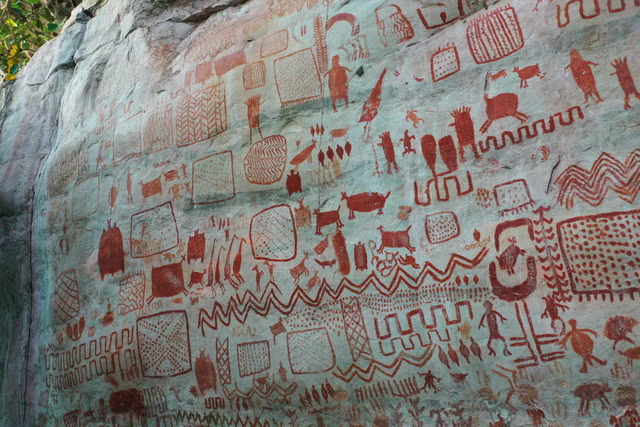A pair of "extremely rare" structures from the early medieval period and evidence of a Roman settlement have been uncovered in the United Kingdom.
The remains were identified during an excavation this summer in Wrexham, a city and county in northeast Wales—one of the constituent countries of the U.K. alongside England and Scotland on the island of Great Britain.
The Roman Empire conquered most of Britain, including Wales, in the first century. The conquered territory, inhabited by Celtic peoples, became the Roman province of Britannia, which existed until the end of the occupation in the 5th century.
A team involving researchers with the University of Chester, England, Heneb: the Trust for Welsh Archaeology and the U.K. government's Portable Antiquities Scheme unearthed important features and materials dated to the Roman era during the Wrexham dig, as well as the early medieval structural remains.
The team found a trackway, building materials, ceramics (including a stamped legionary tile), fragments of a brooch and other remains revealing the presence of a Roman settlement at the Wrexham dig site. The site lies close to a Roman tile and pottery works in Holt, Denbighshire County.
"The Roman settlement is part of a growing pattern of archaeological activity in an area where, aside from military centers, there had been an assumed absence," Heneb project archaeologist and geologist Chris Matthews told Newsweek.
"In the past, the areas surrounding the Roman fortress of Chester have been described as a 'hinterland,' but it is becoming clear that this is more likely a product of a lack of investigation and poor survival rather than an absence of archaeology, meaning that there may be plenty more to find," Matthews said.
The Chester Roman fortress lies just across the modern Anglo-Welsh border from Wrexham.
The research team—which included University of Chester students and local volunteers—also found what appear to be structural remnants of two rectangular timber-built structures dating to the early medieval period, which would likely have had thatched roofs.
These structures are typical of the design of early medieval halls or "longhouses" (long, narrow buildings designed for communal dwelling) that date between the 6th and 11th centuries A.D.
"The early medieval activity is extremely rare because this type of archaeology does not survive well, being largely simple timber and thatch buildings. There are very few examples of this type of timber longhouse in Wales, and again, an almost complete absence in northeast Wales," Matthews said.
"The lack of datable material culture found within the structure is also very typical of the period, with people tending to use materials such as wood, leather and hide for making objects. Unlike ceramic, these are materials that don't survive in the ground."
The first signs of the Wrexham site's archaeological potential came during previous, small-scale investigations conducted by the Holt Local History Society (HLHS) and a local metal detectorist between 2013 and 2017. These investigations uncovered a significant quantity of Roman remains.
"The original investigators were not able to reach a solid conclusion but successfully recovered a large assemblage of artifacts," Matthews said.
"It was once these artifacts were deposited with Wrexham Museum that we [Heneb] were contacted by both the museum and local metal detectorist, Ray. Heneb then partnered [with the University of Chester] to further investigate the site and pick up where HLHS left off."
The research team subsequently conducted geophysical surveys of the site, which revealed a clear outline of a gridded settlement and road system, as well as distinct rectangular structures outside its core. Excavations at the site this year then uncovered further Roman remains, helping to identify the presence of a settlement, and the remnants of the two early medieval longhouses just outside its boundaries.
It is not clear whether the early medieval structures were built next to the Roman settlement deliberately, but some remnants, such as its roadway, may have survived into the early medieval period, or at least been in part perceivable, according to Matthews.
"We were very hopeful of finding evidence of Roman life due to previous discoveries and geophysical surveys in the area, not to mention the presence of the legionary tileworks a few fields away, but did not expect our excavations to uncover what is believed to be an early medieval longhouse," Caroline Pudney, senior lecturer in archaeology at the University of Chester, said in a press release.
Despite the large number of remains found at the site, the team has yet to positively identify a Roman structure.
"But we think that's because we are digging into the wrong part of the settlement," Matthews said. "There is a high probability that at least some of the structures dating to the Roman occupation were roundhouses, a type of structure that is also very difficult to identify, especially in the type of sand and gravel geology we have around Wrexham. They can be almost invisible in archaeological geophysics."
It is currently too early to tell, but based on the proximity to the legionary tile works in Holt, the Roman site may have been established as a satellite settlement for workers of the works there, or of associated industries that helped facilitate the works.
"There is still a lot to do, we need to get a better image of the Roman occupation and the type of structures being used. This would help confirm what type of community was living here. Further analysis of finds assemblage which will take place as part of our post-excavation process will also aim to answer some of these questions," Matthews said.
Do you have a tip on a science story that Newsweek should be covering? Do you have a question about archaeology?Let us know via science@newsweek.com.
Disclaimer: The copyright of this article belongs to the original author. Reposting this article is solely for the purpose of information dissemination and does not constitute any investment advice. If there is any infringement, please contact us immediately. We will make corrections or deletions as necessary. Thank you.



